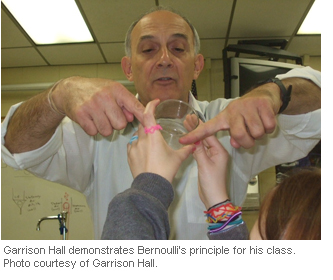
South Carolina Teacher's NASA Experience Earns STELLAR Award
Jun 10, 2010
 A veteran South Carolina science teacher looking for ways to ramp up his skills for a new class of older students turned to NASA for help and has earned a STELLAR Award from the NASATalk web-based collaborative for his efforts.
A veteran South Carolina science teacher looking for ways to ramp up his skills for a new class of older students turned to NASA for help and has earned a STELLAR Award from the NASATalk web-based collaborative for his efforts.The STELLAR Awards recognize excellent uses of NASA science, technology, engineering, and mathematics (STEM) materials by educators in classrooms or informal settings. For Garrison Hall the award and its $100 stipend affirm his belief that he came to the right place when he needed help.
Hall spent his first 27 years teaching elementary school, fifth grade science in particular in his last position. This past school year the Massachusetts native moved up to eighth grade science at L.E. Gable Middle School in Roebuck, SC. Even with all those years of teaching behind him, Hall considered himself a first-year middle school teacher and felt the need to prepare for the new challenge, so he got himself on a waiting list for a NASA STEM workshop in Charlotte.
"As a first-year eighth grade science teacher, I needed all the help I could get," Hall said.
He eventually was invited to the workshop as the lone representative from South Carolina. The NASA educational activities he experienced and the insights he learned about how things work at the space agency changed his approach to teaching and gave him a new enthusiasm.
"This is the way that people like NASA think and problem solve," Hall recalled of three activities from the On the Moon Educator's Guide he took from the workshop and had his eighth-graders try. "(My students) had to make the little car (a simulated rover). Another team had to make the crane (made of cardboard), the cups for the zip line (modify a paper cup so it can zip down a line and drop a marble onto a target). And I saw how that all worked together because this is the first time I've ever done anything like that. It just amazed me how the activities are real world applications even though I am using cheap stuff from the grocery store. But the thought process they had to go through, how they had to work with each other, and how they had to plan—it was amazing. I said, this is the way I need to be teaching. This depth right here. Not just questions out of a book, not just the simple answer from the just knowledge level."
Hall said his students were caught off guard at first by the changes in his teaching style—moving from a more authoritarian, lecturing style to that of a facilitator of learning. Later, though, students started their science periods by asking Hall what he was going to do that day.
Hall also learned about digital editing at the STEM workshop and soon put his students to work on video productions for their astronomy unit. Using green screen technology he learned about at the workshop, he showed the students how they could be superimposed in front of any kind of background. Students worked in teams, using software such as Windows MovieMaker, PhotoStory, or iMovie to illustrate their presentations about Mars, Jupiter, Newton's Laws, and the Moon.
In his STELLAR Award entry Hall attached a vodcast of two students' presentation on lunar eclipses. Hall located a lunar eclipse video from the NASA eClips available free online for students and educators and worked with a green screen to superimpose one student into the video. The other student provided percussion accompaniment for the clip, a defining moment for the student.
"It really made him feel wonderful that I chose him to do that," Hall said. "He made a couple of recordings for me. He spent hours on it. He kept asking me, 'How's this, Mr. Hall?' He felt so proud."
This summer Hall is teaching physical science to other teachers at the Roper Mountain Science Center in Greenville, SC.
Educators are invited to apply each month for the STELLAR Awards at the NASATalk website, which was created and is hosted by the NASA-sponsored Classroom of the Future.
The STELLAR acronym represents the intent of the award: STEM Teaching Excellence for Leading, Learning, Articulation, and Reflection. The STELLAR Awards are given regularly based on certain themes, such as human spaceflight, Earth science, aeronautics, astronomy, space science, and exploration. A nomination can be completed at the NASATalk website. The online form outlines the award criteria and encourages thoughtful, complete reflections about using NASA products.



